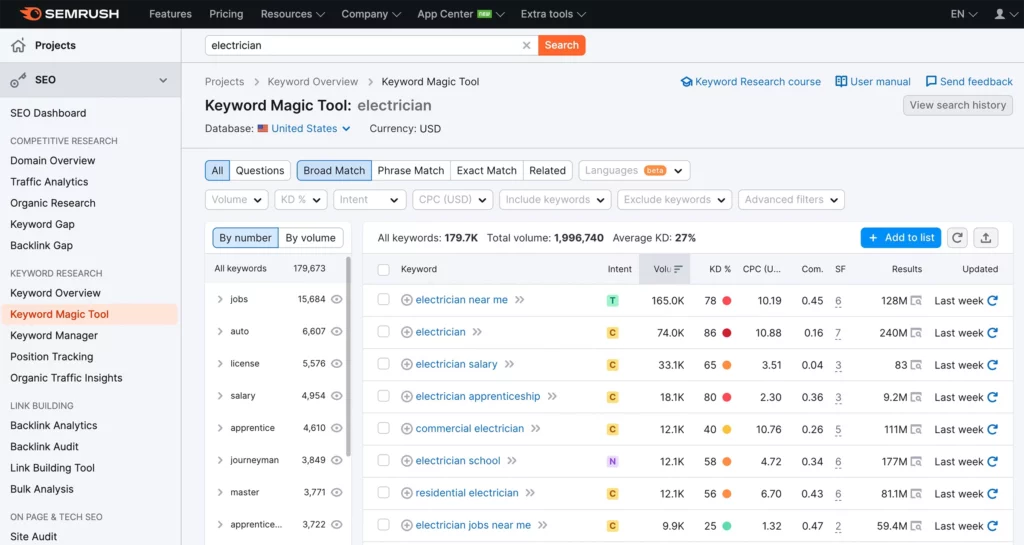Is your website stale? There are big benefits that can come if you know how to rewrite website content.
In the ever-evolving digital landscape, keeping your website content, copywriting, and blog posts fresh and up-to-date is crucial for maintaining a strong online presence.
Regularly rewriting and updating your content ensures that your website remains relevant, engaging, and valuable to your target audience.
Additionally, it helps you stay ahead of your competitors and adapt to changes in your industry, customer behavior, and market trends.
Learning how to rewrite website content, copywriting, and blog posts can also benefit your brand by showcasing your expertise, building trust with your audience, and establishing a consistent brand voice.
It enables you to present a professional image, which in turn can lead to increased customer loyalty and conversions.
Improved Engagement and SEO if You Know How to Rewrite Website Content
The primary goals of rewriting website content, copywriting, and blog posts are to improve user engagement and optimize your website for search engine optimization (SEO).
By providing high-quality, relevant, and engaging content, you can encourage users to spend more time on your site, share your content with others, and ultimately convert into customers or subscribers.
Optimizing your content for SEO ensures that your website ranks higher in search engine results, increasing visibility and driving organic traffic to your site. This involves incorporating relevant keywords, improving readability, and ensuring that your content is structured and formatted correctly for search engines.
By combining engaging content with SEO best practices, you can maximize your website’s potential to attract and retain visitors.
Identifying Your Audience
Before you begin rewriting your website content, copywriting, or blog posts, it’s essential to have a clear understanding of your target audience. Knowing who you’re writing for will allow you to create content that resonates with them and addresses their needs.
Here are some steps to help you identify your target audience:
- Create audience personas: Develop detailed profiles of your ideal customers or users, including demographic information, interests, pain points, and goals. These personas will help guide your content creation process.
- Analyze website and social media analytics: Use tools like Google Analytics and social media insights to gather data about your existing audience. This information can help you identify trends and preferences.
- Conduct market research: Use surveys, interviews, or focus groups to gather firsthand insights about your target audience’s needs and preferences.
- Monitor online conversations: Engage with your audience on social media, forums, and blog comments to understand their opinions, questions, and concerns.
How to Rewrite Website Content and Tailor it to Audience Preferences and Needs
Once you have a clear understanding of your target audience, you can tailor your content to meet their preferences and needs.
Consider the following tips to create content that resonates with your audience:
- Address pain points and challenges: Identify the common problems and issues your audience faces and provide solutions through your content.
- Use an appropriate tone and style: Depending on your target audience, you may need to adopt a formal, informal, conversational, or professional tone. Always keep the language easy to understand.
- Provide value: Offer valuable information, insights, or resources that your audience will find helpful, such as tips, guides, or case studies.
- Use preferred content formats: Different audiences may prefer different content formats, such as articles, videos, infographics, or podcasts. Experiment with various formats to see which ones resonate best with your audience.
- Engage with your audience: Encourage interaction and dialogue through comments, social media, or email to foster a sense of community and gather feedback for future content improvements.
How to Rewrite Website Content
Before you start rewriting your website content, it’s essential to conduct a thorough content audit. A content audit involves evaluating all the content on your website to identify areas for improvement and optimization.
Perform a Content Audit
Follow these steps for a successful content audit:
- Make a content inventory: Create a list or spreadsheet of all your website’s pages, including URLs, titles, descriptions, and any other relevant information.
- Analyze performance: Use analytics tools to assess the performance of each page, including traffic, engagement, bounce rate, and conversion rate.
- Identify strengths and weaknesses: Based on your analysis, determine which pages are performing well and which ones need improvement.
- Prioritize: Rank the pages that need improvement based on factors like importance, potential impact, and available resources.
Revise for Clarity and Conciseness
As you rewrite your website content, focus on making it clear and concise. Here are some tips to help you achieve this:
- Use simple language: Avoid jargon, complex terms, or lengthy sentences that may confuse your readers.
- Be specific: Use concrete examples, facts, and figures to support your points and provide context.
- Break up long paragraphs: Divide long paragraphs into shorter ones to improve readability and make the content more digestible.
- Use headings and subheadings: Organize your content using headings and subheadings to make it easy for readers to scan and find relevant information.
- Edit ruthlessly: Remove unnecessary words, phrases, or sentences that don’t add value or could be confusing. Search engines are not fond of fluff!
Update Outdated Information
When rewriting your website content, make sure to update any outdated information, such as old statistics, product features, or contact details. This helps maintain your website’s credibility and ensures that users can rely on the information you provide.
Regularly review your content to identify any areas that need updating.
How to Rewrite Website Content and Redirect Old Links
As you rewrite your website content, it’s important to think about the structure of your web pages and any links connected to them.
Redirecting old links or pages or posts that you eliminate is a crucial step in maintaining the flow of your website. This ensures that visitors won’t be met with broken links or 404 errors when they click on an outdated link.
It also allows you to maintain your site’s search engine rankings and avoid any confusion related to duplicate content.
Redirecting takes some time, but it’s well worth the effort for a successful website!
There are several good redirection plugins that help make this job easier:
- Redirection – This free WordPress plugin with over 2 million active installations can help you easily manage 301 redirections and keep track of 404 errors.
- Simple 301 Redirects – This free plugin is an easy way to manually create quick 301 redirects.
- Safe Redirect Manager – This free plugin helps you manage safe and efficient redirections while preventing harmful or malicious redirects.
- Rank Math SEO – The Rank Math SEO plugin provides users with a comprehensive set of features, including a powerful redirection manager that allows users to quickly and easily create, update, or delete 301, 302, and 307 redirections.
- WPML Redirect – WPML Redirect is a simple yet powerful WordPress plugin designed to automatically handle the language-based redirection needs associated with multilingual sites powered by WPML Multilingual CMS plugin suite.
Enhance User Experience (UX) and Design
Improving the user experience (UX) and design of your website is crucial for keeping visitors engaged and encouraging them to explore further.
Consider these tips to enhance UX and design when rewriting your website content:
- Use consistent formatting: Maintain a consistent format and style throughout your website to make it easy for users to navigate and understand the content.
- Optimize visuals: Use high-quality images, infographics, or videos to illustrate your points and make your content more appealing.
- Improve page load speed: Optimize your images, minimize CSS and JavaScript, and leverage browser caching to ensure your pages load quickly.
- Ensure mobile-friendliness: Make sure your website is responsive and easy to use on mobile devices, as more users access websites through their smartphones and tablets.
- Incorporate white space: Use white space effectively to make your content more readable and visually appealing.
How to Rewrite Website Copywriting
Before rewriting your copywriting, it’s essential to evaluate its current effectiveness. This will help you identify areas for improvement and ensure that your revised copy aligns with your goals.
To assess your current copywriting effectiveness consider the following factors:
- Conversion rates: Analyze the conversion rates for your current copy, such as the number of leads, sales, or subscriptions generated.
- Engagement metrics: Look at metrics like time spent on the page, bounce rate, and click-through rates to determine how well your copy is engaging your audience.
- Feedback: Gather feedback from your audience through surveys, comments, or social media to identify any areas of confusion or dissatisfaction.
Use Persuasive and Engaging Language
When rewriting your copywriting, focus on using persuasive and engaging language that resonates with your target audience. Keep these tips in mind:
- Focus on benefits: Highlight the benefits of your product or service, rather than just listing features. Explain how it solves a problem or fulfills a need for your audience.
- Use storytelling: Incorporate storytelling techniques to create an emotional connection with your audience and make your copy more memorable.
- Address objections: Identify potential objections or concerns your audience may have and address them in your copy.
- Leverage social proof: Include testimonials, reviews, or case studies to demonstrate the value of your product or service and build trust with your audience.
Implement Strong Calls-to-Action (CTAs)
Effective copywriting includes clear and compelling calls-to-action (CTAs) that guide your audience toward a desired action.
When rewriting your copy, consider the following CTA best practices:
- Be clear and specific: Clearly state what action you want your audience to take, such as “Sign Up Now” or “Download the Free Guide.”
- Use action-oriented language: Use strong verbs and an active voice to create a sense of urgency and encourage immediate action.
- Make it visually prominent: Ensure your CTA stands out on the page through the use of contrasting colors, large font sizes, or eye-catching design elements.
- Test and optimize: Experiment with different CTA copy, placements, and designs to determine which combinations work best for your audience and goals.
Examples of Calls-To-Action That Will Encourage Visitors to Take a Specific Action
When rewriting your website, it’s important to consider CTAs that will encourage visitors to take a specific action. Here are some examples of effective CTAs:
- “Sign up for our newsletter!”
- “Download our free guide!”
- “Book a consultation today!”
- “Shop now!”
- “Subscribe now for exclusive offers!”
- “Follow us on social media!”
- “Donate now to help make a difference!”
Maintain Brand Consistency
As you rewrite your copywriting, it’s crucial to maintain consistency with your brand’s voice, tone, and messaging. This helps build trust and familiarity with your audience, making it more likely that they’ll engage with your content and take action.
To ensure brand consistency:
- Develop a brand style guide: Create a guide that outlines your brand’s voice, tone, and messaging guidelines. Share it with your team to ensure everyone is on the same page.
- Align with audience personas: Keep your target audience personas in mind when writing your copy, and make sure your language and tone resonate with them.
- Review existing content: Look at your existing content and make sure it aligns with your brand guidelines. Update any content that doesn’t match your desired voice or tone.
- Edit and proofread: Carefully review your revised copy for spelling, grammar, and punctuation errors, as well as adherence to your brand guidelines.
Rewriting Blog Posts
Over time, blog posts can become outdated or less relevant, making it essential to refresh them to maintain their value and appeal to your audience.
Here’s how to rewrite website content and refresh outdated blog posts:
- Update facts and figures: Replace old statistics, research findings, or examples with the most recent data available.
- Add new insights or developments: Include any recent industry trends, innovations, or news that impact your topic.
- Remove irrelevant or outdated information: Eliminate any content that no longer applies or has been superseded by new information.
- Revise the title: If necessary, update the title to better reflect the current content and make it more engaging.
Improve Readability and Formatting
When rewriting blog posts, ensure that they are easy to read and visually appealing. Follow these tips to improve readability and formatting:
- Use short paragraphs: Break your content into shorter paragraphs to make it easier to digest.
- Use headings and subheadings: Organize your content with clear headings and subheadings, making it simple for readers to navigate and scan.
- Use bullet points or numbered lists: Present lists or key points in a bullet or numbered format for better readability.
- Enhance visuals: Incorporate relevant images, infographics, or videos to break up text and provide visual interest.
How to Rewrite Website Content and Optimize for Keywords and Search Intent
To improve your blog posts’ search engine ranking, optimize them for relevant keywords and search intent. Here’s how:
- Perform keyword research: Identify the primary and secondary keywords that your target audience is using to search for content related to your topic.
- Include keywords strategically: Incorporate your keywords naturally throughout your content, including in the title, headings, and body text.
- Focus on search intent: Ensure that your content aligns with the search intent behind your target keywords. This means providing the information, answers, or resources that users are searching for.
- Avoid keyword stuffing: Do not overuse keywords, as this can lead to penalties from search engines. Keep your keyword usage natural and relevant to the content.
Incorporate Internal and External Links
Adding internal and external links to your blog posts can enhance their value, improve SEO, and keep readers engaged. Consider these tips for incorporating links:
- Link to relevant internal content: Link to other relevant blog posts or pages on your website to provide additional resources and keep readers engaged with your content.
- Include authoritative external links: Link to reputable external sources to support your claims, provide further information, or offer different perspectives.
- Use descriptive anchor text: Use clear and descriptive anchor text for your links to help both users and search engines understand the context of the linked content.
- Check for broken links: Regularly review your blog posts to identify and fix any broken links, as these can negatively impact user experience and SEO.
Additionally, when updating your blog posts, it’s a good practice to change the “date published” or “date updated” information for both visitors and search engines. This shows that the content is current and fresh, which can boost your credibility and search engine rankings.
Make sure to clearly indicate the last updated date near the top of your blog post to keep your readers informed.
How to Rewrite Website Content by Utilizing SEO Best Practices
Keyword research is a fundamental aspect of SEO. It helps you understand the terms and phrases your target audience uses to search for content related to your niche.
To perform keyword research:
- Use keyword research tools: Tools like Google Keyword Planner, SEMrush, or Ahrefs can help you identify relevant keywords based on search volume, competition, and user intent.
- Analyze competitors: Examine the keywords your competitors are targeting to identify potential opportunities or gaps in your own strategy.
- Focus on long-tail keywords: Target-specific, low-competition long-tail keywords that are more likely to drive targeted traffic and conversions.
- Monitor keyword performance: Regularly track your keyword rankings. Adjust your strategy as needed to maintain or improve your position in search results.
Optimize Meta Tags and Headings
Meta tags and headings play a crucial role in helping search engines understand and index your content. To optimize them:
- Craft compelling meta titles: Create unique, engaging meta titles that include your target keywords and accurately represent the content of the page.
- Write descriptive meta descriptions: Write concise, informative meta descriptions. They should provide a summary of the page content and encourage users to click through from search results.
- Use heading tags (H1, H2, H3, etc.): Structure your content using heading tags to create a clear hierarchy. This makes it easier for search engines to understand the organization of your content.
- Include keywords in headings: Incorporate your target keywords into your headings and subheadings where appropriate and natural.
Improve Page Load Times
Fast-loading pages are essential for both user experience and SEO. To improve your page load times:
- Optimize images: Compress and resize images to reduce file sizes without sacrificing quality.
- Minify code: Minify your HTML, CSS, and JavaScript files to remove unnecessary characters and whitespace, reducing file sizes and improving load times.
- Use browser caching: Implement browser caching to store static files on users’ devices, reducing the need to download them on subsequent visits.
- Utilize a content delivery network (CDN): Use a CDN to deliver static files from servers closer to users, resulting in faster load times.
Use Schema Markup
Schema markup is a form of structured data that helps search engines understand your content more effectively and potentially generate rich snippets in search results. To use schema markup:
- Choose the appropriate schema type: Determine the most suitable schema type for your content, such as Article, Product, Review, or Event.
- Generate schema code: Use a schema markup generator, like Google’s Structured Data Markup Helper or Schema.org’s tools, to create the necessary code.
- Add schema code to your pages: Insert the generated schema code into the HTML of your web pages. Follow the guidelines provided by the schema generator.
- Test your implementation: Use Google’s Rich Results Test or a similar tool to verify that your schema markup has been implemented correctly and is recognized by search engines.
How to Rewrite Website Content and Measure and Track Results
To measure the effectiveness of your content rewriting efforts and track your progress, use analytics tools like Google Analytics, Adobe Analytics, or similar platforms.
These tools can provide valuable insights into your website’s performance, user behavior, and the impact of your content updates.
Some important metrics to track include:
- Organic traffic: Monitor the number of visitors coming to your website from search engines. This can indicate the success of your SEO efforts.
- Bounce rate: Keep an eye on the percentage of visitors who leave your website after viewing only one page. It can indicate issues with content quality or user experience.
- Time on page: Track the average amount of time users spend on your pages. This can help gauge the level of engagement with your content.
Monitor Engagement and Conversion Rates
Tracking engagement and conversion rates can help you determine the success of your content rewriting and optimization efforts. Some key metrics to consider include:
- Pageviews: Monitor the number of times users view your pages, which can indicate the popularity and effectiveness of your content.
- Click-through rate (CTR): Assess the percentage of users who click on your calls-to-action (CTAs) or other links within your content. This can demonstrate the persuasiveness of your copy.
- Conversion rate: Track the percentage of users who complete a desired action. Check statistics on signing up for a newsletter, making a purchase, or filling out a contact form. Higher conversion rates often indicate more effective content.
Adjust Strategies Based on Data
Using the data gathered from analytics tools and engagement metrics, adjust your content rewriting and optimization strategies as needed to improve performance.
Some potential adjustments might include:
- Refining your keyword strategy: If certain keywords aren’t performing well, consider targeting new or different keywords. Choose ones that better align with your audience’s search intent.
- Improving user experience: If users are consistently leaving your website quickly or not engaging with your content, evaluate your website’s design, navigation, and overall user experience to identify areas for improvement.
- Updating your content: Continually review and update your content to ensure it remains relevant, accurate, and engaging for your audience. Regularly refresh your website content, copywriting, and blog posts to maintain their effectiveness and improve your SEO and engagement metrics.
Conclusion and Final Thoughts on How to Rewrite Website Content
In conclusion, rewriting website content, copywriting, and blog posts is crucial. It will help you with maintaining your online presence and staying competitive in today’s digital landscape.
Refreshing your content not only improves user engagement and experience, but it also enhances your website’s search engine optimization (SEO), driving more organic traffic and conversions.
By tailoring your content to your target audience, optimizing for keywords and search intent, and implementing SEO best practices, you can ensure that your website remains relevant, informative, and appealing to both users and search engines.
Consistent Content Updates for Ongoing Success
To achieve ongoing success, it’s essential to make content updates and optimizations a regular part of your digital strategy. Continuously monitor your analytics, engagement metrics, and industry trends to identify areas for improvement and opportunities for growth.
Stay committed to providing valuable, up-to-date content that resonates with your target audience and meets their needs. By doing so, you’ll create a strong foundation for long-term success. You will build trust and credibility with your audience and maintain a competitive edge in your niche.
When is the last time you did a big website rewrite? Tell us all about it in the comment section below.





